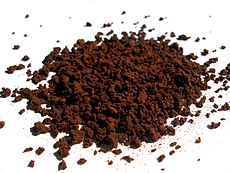Recently I was approached by a guy I met briefly several years ago when we were setting up Dr. Coffee’s Café – he (or at least, someone on his team) actually designed our logo and signage for us. I remembered him because he was very personable, seemed like the type who ought to be the patron of some amateur theatre troupe. And also because we had a meeting in Robin’s, where the coffee was so bad I threw up in the bathroom (mainly due to pregnancy, I should add). Anyway, that was early 2015. I am amazed he remembered me!
He is no longer making signs. Instead, he wanted to talk to me about an amazing business opportunity. Alarm bells rang. I am wary about that sort of sales pitch. However, he told me it was coffee related, so always worth checking out, I reckon.

Coffee in the very loosest sense, apparently. The poor guy has got himself mixed up with Valentus. It’s one of those MLM schemes and he was trying to recruit me into the bottom of a strangely triangular type of business model, if you get my drift. The product that allows you “an opportunity for an extraordinary life” and a global business that you can run from home, with the chance to make 6-figure monthly incomes, is called Slim-Roast. This magical substance is part energy-drink, part weight-loss supplement and part soluble coffee.
Not one part of that last sentence enamors me to the product.
According to Valentus’ website, this drink powder is
Great for:
- Controls appetite
- Regulates sugar absorption
- Regulates fat absorption
- Promotes brain health and focus
- Elevates mood
- Antioxidant
Aside from the obvious grammar error, black coffee manages all of that on its own with neither the bizarre additives nor the hefty price tag. Apparently though, this is coffee mixed with green tea extract, l-theanine (also a green tea extract) and cacoa (raw chocolate) AND added caffeine. This all produces a substance with 127mg of caffeine for every 8oz fluid ounces, which is roughly double the strength of a can of Red Bull, but without the sugar.
As I have said before, caffeine itself doesn’t actually give you an energy boost (you get that from the sugar in most energy drinks). Instead, you feel more alert after a caffeine boost because caffeine molecules inhibit adenosine receptors in the brain, which are the bit that makes you feel tired. You’re not actually any less tired if you drink coffee, you just don’t feel it until your body metabolises the caffeine. Caffiene already does all the other stuff to some extent: it’s a minor appetitie supressent, it boosts your mood and helps you focus, keeps your brain healthy and can boost your metabolism. But in excess it leads to anxiety, insomnia and hypertension. There is no good reason to add more caffeine to an already beneficial caffeinated drink.
The green tea, the cacao and then ‘green coffee bean extract’ AND extra chlorogenic acid (again with the overkill) are all supposed to increase your anti-oxident intake. It’s also, somehow, made soluable. I wrote about why this is bollocks here.
There is also ‘Garcinia Cambogia’ (tamarind, in other words) which is touted as another appetite suppressant, and Phaseolamin (derived from cannelli beans) that apparently stops your guts from digesting some starches so they pass through you without you taking in so many calories. The key bit there is ‘passing through you’. What is another thing coffee is well known for? Making you poop. The coffee and the raw coffee extract, the tamarind, the phaseolamin and the other superfluous additives come together to form one big … laxative. I guess that would help you lose weight then.
YUCK.
Inevitably though, the product is NOT the main focus of this enterprise. No, this guy was not looking to sell Slim Roast to me, he wanted to recruit me to sell it to other people. I’d have to agree to buy a certain amount from Valentus, and I’d only start getting commission on it if I sell a specific amount every month. The real money only starts when you recruit four people, as you then get commission off their sales too. Ignoring the way the products play in to the cult of being busy, fetishizing stress and the need for constant energy and alertness, or preying on people’s body insecurities (yeah, I really don’t like this stuff!) – someone, somewhere is going to get ripped off. The whole thing relies on people feeding money upwards, and not everyone is going to succeed.
As this guy correctly points out, coffee, weight loss products and energy drinks are all massive global industries right now. I am sure there is a huge market out there for this stuff, somewhere. But it’s not a market I want to step foot into. I am a coffee geek, that’s my passion. I don’t think I am capable of selling anything I don’t believe in, and putting my name to any sort of psuedoscience-hyped coffee derivitive would be the ultimate sell-out. I’ve accepted the fact that my business passion projects are never going to make me rich, and that is fine. I’d much rather be poor and drink real coffee!!





